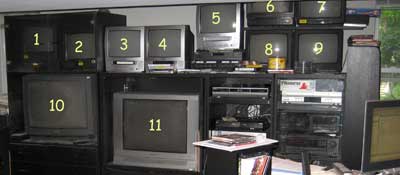 Yesterday I checked out, for the first time, the office I'll be using when I become a full-time college professor, teaching TV and film at Rowan University in New Jersey. It had enough room that I requested a media roller cart, so I could house my dad's first TV set there and do something I've wanted to do for 10 years as an adjunct professor.
Yesterday I checked out, for the first time, the office I'll be using when I become a full-time college professor, teaching TV and film at Rowan University in New Jersey. It had enough room that I requested a media roller cart, so I could house my dad's first TV set there and do something I've wanted to do for 10 years as an adjunct professor.

Namely, I want to wheel a vintage 1946 TV set into the auditorium where we teach TV History, plug it in, and show these twentysomething students what it was like to watch TV on a small oval screen, pulling signals from out of the air as if by magic.
But I'd better hurry.
I'd better hurry, because I can pull this trick only twice: When the fall term begins in September, and after that, when the winter term begins in January. After that, TV broadcasters will stop broadcasting analog signals. At midnight on February 17, the way that television was first transmitted into homes will become one more thing of the past.

There are ways to prepare for this. You can continue to use old, over-the-air sets by attaching digital-to-analog converter boxes, and the government is issuing coupons, two to a household, worth $40 each toward the purchase of an approved converter box. Coupons can be requested by phoning 888-DTV-2009, or by going to the www.DTV2009.gov website.
Newer sets have digital tuners, and sets attached to cable TV will get those signals unaffected. But digital isn't the same as high definition -- and I worry about the poorest people in the poorest communities, where cable and Internet access are out of reach, and where even free government coupons aren't likely to reach them.
In those homes, over-the-air broadcasts such as Sesame Street on PBS are among the greatest gifts, and most valuable learning tools, TV and our society can offer. How unfair is it that the viewers who need Bert and Ernie the most may soon be the least likely to be able to watch them?

And speaking of unfair, I'm kind of really messed up by this. My basement office has so many TVs that when one friend, author Kent Rasmussen, visited, he not only photographed my television sets, but numbered them on the photo he sent back. That's the photo at the top of today's blog (he also took the other photos of random old TVs around my house) -- and except for the two big ones, almost all those tiny TV sets are analog.
Right now, I can watch 12 TV images at the same time (there's one set out of frame in Kent's sarcastically numbered photo). In a few months, unless I plan ahead, it'll be two. Even Elvis and LBJ could watch more TV images at a time than that...